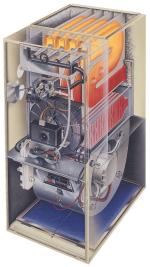Search engine visitors - click here to access entire "$ensible Home" web site
Click here to see a descriptive illustration of where a house loses heat and the percentages.
Dear Jim: My utility bills are higher than my neighbors even though I have tried to make my house more efficient. I am considering getting an energy audit. The prices vary a lot. What type of energy audit is best? - H. D.

A: If your utility bills seem excessively high as compared to similar houses in your area, even though you have made your house more efficient, first check the biggest energy user - the furnace. Most older furnaces were sized too large for the houses initially. Now that your house is more efficient and loses less heat, the furnace output may be far too large and it may be time to get a new one.
An oversized furnace wastes a lot of energy. Since it is too large for your house, it does not have to run much except in the coldest weather. This results in high off-time losses when it is not running. It also cycles on and off more often creating more losses and fluctuating temperatures.
The most accurate method to check the size of your furnace is to have your furnace technician do a computerized heat loss analysis of your entire house. There often is a charge for this service. A simple do-it-yourself off-time check can estimate if your furnace is too large. It is based on the severity of your climate and the outdoor temperature.
In a mild climate with 3,000 heating degree days (HDD), a properly-sized furnace will run 44 minutes per hour when it's 30 degrees outdoors. In a more severe climate with 6,000 HDD, it should run only 34 minutes. A more severe climate requires a larger furnace to handle the coldest days.
The best types of energy audits use infrared thermography and blower door infiltration tests plus a detailed inspection by a technician. The cost of an energy audit can be many hundreds of dollars for a "hi-tech" computerized analysis. There are "house doctors" that do the energy audit analysis and make many simple improvements the same day.
Infrared thermography uses a camera with heat sensitive film or special scanners. Hot areas appear red and cold areas appear blue. This is an excellent method for detecting voids in wall insulation. Pictures and scans from both inside and outside are most effective.
A blower door test is used to determine the amount of air leakage into a house and where the air leakage is occurring. A large fan is positioned in a window or a door and it sucks air out of the house. This negative pressure draws outdoor air in any leaky areas so they are easier to detect.
Instant Download Update Bulletin No. 837 - furnace sizing off-time and heating degree days (HDD) charts for 100 cities, a do-it-yourself home energy evaluation check list (house exterior, roof, attic, basement/crawl space, furnace, water heater, appliances, general) and energy audit worksheets.
Dear Jim: We have a vent fan in our bathroom that vents into a duct in our attic. During cold weather, water drips off of the grill and I can feel a warm draft leaking up through it. What can I do to fix this? - W. S.
A: If your attic is well insulated and properly ventilated, the air above the insulation stays cold. Since most bathroom vents use a metal duct, the duct also gets cold. This allows the moisture to condense and it runs down and drips out the grill.
Run the fan a little longer after your shower. This clears the moisture-laden air out of the duct before it condenses. Also check for spring dampers in the duct. They should close when the fan is off to block air leakage.